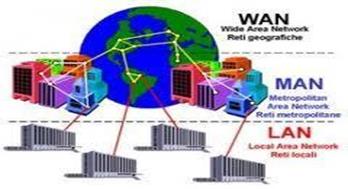Classification of computer networks by scale
According to the Table 5 above, the networks can be classified into six classes abbreviated as PAN, LAN, MAN and GAN.
Personal Area Network (PAN)
A personal area network (PAN) is a computer network that will be useful in communicating computerizes devices such as telephones and PDAs. Mostly, the PAN is communicated through wireless network technologies such as Wireless USB, Bluetooth, Z-Wave, and IrDA. You may use PANs to communicate among the personal devices or you may connect even to higher level networks or to the internet.

Figure 10- Personal Area Network
Local Area Network (LAN)
A local area network (LAN) is a computer network covering a small geographic area, like a home, office, or group of buildings. Ex: a school (See Figure 11 below). The defining characteristics of LANs, in contrast to Wide Area Networks (WANs), include their much higher data transfer rates, smaller geographic range, and lack of a need for leased telecommunication lines. LANs can be small, linking as few as three computers, but often link hundreds of computers used by thousands of people. The development of standard networking protocols and media has resulted in worldwide propagation of LANs throughout business and educational organizations. The Figure 11 below shows a LAN consisting of six computers/work stations.

Figure 11- Local Area Network (LAN) Figure 12- LAN in a School
Wide Area Network (WAN)
Wide Area Network is defined as a group of computers and network devices connected across large physical areas such as states or countries. Computers connected to a Wide Area Network are often connected through the telephone system. They can also be connected through leased lines or satellites. One may define a WAN as a collection of several LANs as depicted in Figure 13 below.
The largest WAN in existence is the Internet. (You will learn about Internet in a coming section).

Figure 13- Wide Area Network
Metropolitan Area Network (MAN)
MAN is a network that interconnect users with computer resources in a geographic area or region larger than that covered by a local area network (LAN) but smaller than the area covered by wide area network (WAN). Further a MAN is a network that connects two or more Local Area Networks or Campus Area Networks together but does not extend beyond the boundaries of the immediate town, city, or metropolitan area. See Figures 14,15 below for a typical set up of a MAN.

Figure 14- Metropolitan Area Network (MAN)

Figure 15- LAN, MAN, and WAN
Дата добавления: 2017-05-18; просмотров: 4154;
